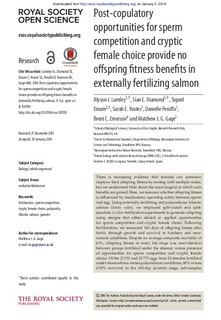| dc.contributor.author | Lumley, Alyson J. | |
| dc.contributor.author | Diamond, Sian E. | |
| dc.contributor.author | Einum, Sigurd | |
| dc.contributor.author | Yeates, Sarah E. | |
| dc.contributor.author | Peruffo, Danielle | |
| dc.contributor.author | Emerson, Brent C. | |
| dc.contributor.author | Gage, Matthew J.G. | |
| dc.date.accessioned | 2018-01-03T09:08:38Z | |
| dc.date.available | 2018-01-03T09:08:38Z | |
| dc.date.created | 2016-07-06T13:40:36Z | |
| dc.date.issued | 2016 | |
| dc.identifier.citation | Royal Society Open Science. 2016, 3 . | nb_NO |
| dc.identifier.issn | 2054-5703 | |
| dc.identifier.uri | http://hdl.handle.net/11250/2474239 | |
| dc.description.abstract | There is increasing evidence that females can somehow improve their offspring fitness by mating with multiple males, but we understand little about the exact stage(s) at which such benefits are gained. Here, we measure whether offspring fitness is influenced by mechanisms operating solely between sperm and egg. Using externally fertilizing and polyandrous Atlantic salmon (Salmo salar), we employed split-clutch and split-ejaculate in vitro fertilization experiments to generate offspring using designs that either denied or applied opportunities for sperm competition and cryptic female choice. Following fertilizations, we measured 140 days of offspring fitness after hatch, through growth and survival in hatchery and near-natural conditions. Despite an average composite mortality of 61%, offspring fitness at every life stage was near-identical between groups fertilized under the absence versus presence of opportunities for sperm competition and cryptic female choice. Of the 21 551 and 21 771 eggs from 24 females fertilized under monandrous versus polyandrous conditions, 68% versus 67.8% survived to the 100-day juvenile stage; sub-samples showed similar hatching success (73.1% versus 74.3%), had similar survival over 40 days in near-natural streams (57.3% versus 56.2%) and grew at similar rates throughout. We therefore found no evidence that gamete-specific interactions allow offspring fitness benefits when polyandrous fertilization conditions provide opportunities for sperm competition and cryptic female choice. | nb_NO |
| dc.language.iso | eng | nb_NO |
| dc.publisher | The Royal Society | nb_NO |
| dc.rights | Navngivelse 4.0 Internasjonal | * |
| dc.rights.uri | http://creativecommons.org/licenses/by/4.0/deed.no | * |
| dc.title | Post-copulatory opportunities for sperm competition and cryptic female choice provide no offspring fitness benefits in externally fertilizing salmon | nb_NO |
| dc.type | Journal article | nb_NO |
| dc.type | Peer reviewed | nb_NO |
| dc.description.version | publishedVersion | nb_NO |
| dc.source.pagenumber | 12 | nb_NO |
| dc.source.volume | 3 | nb_NO |
| dc.source.journal | Royal Society Open Science | nb_NO |
| dc.identifier.doi | 10.1098/rsos.150709 | |
| dc.identifier.cristin | 1366514 | |
| dc.relation.project | Norges forskningsråd: 223257 | nb_NO |
| dc.description.localcode | © 2016 The Authors. Published by the Royal Society under the terms of the Creative Commons Attribution License http://creativecommons.org/licenses/by/4.0/, which permits unrestricted use, provided the original author and source are credited. | nb_NO |
| cristin.unitcode | 194,66,10,0 | |
| cristin.unitname | Institutt for biologi | |
| cristin.ispublished | true | |
| cristin.fulltext | original | |
| cristin.qualitycode | 1 | |

